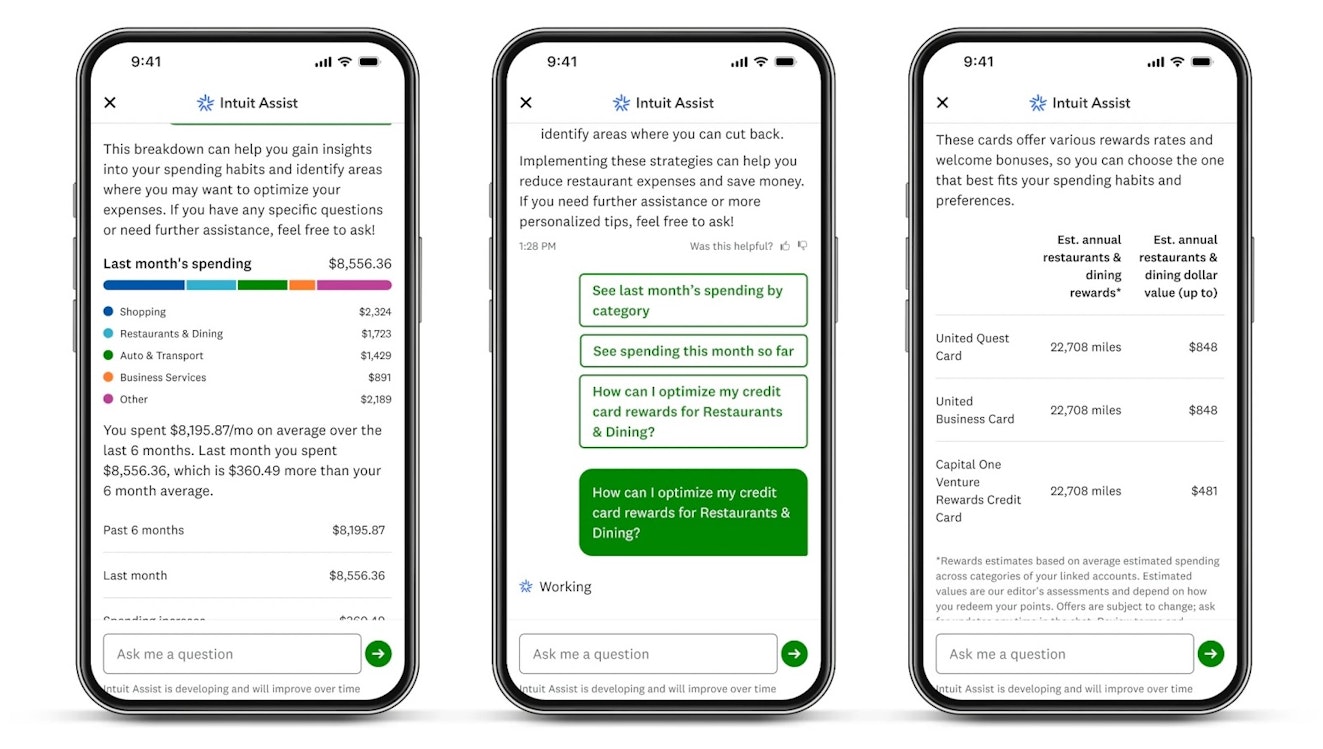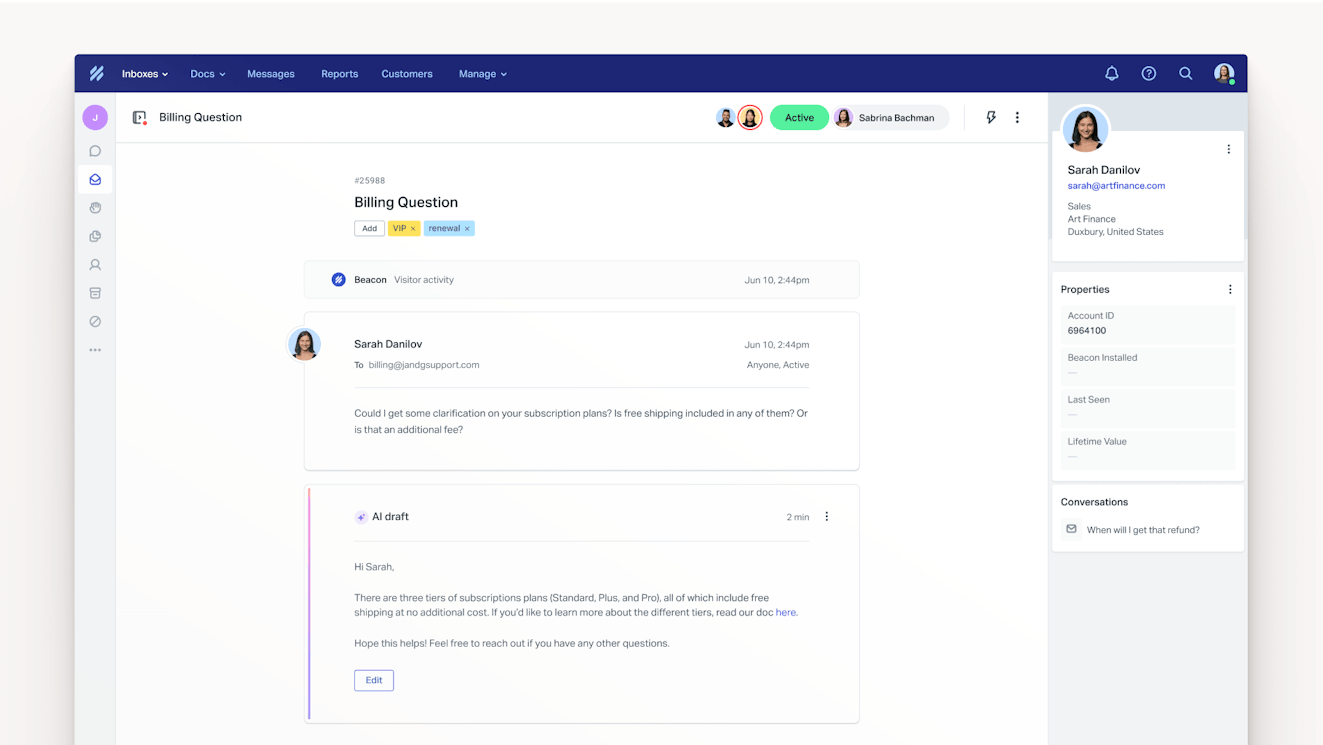
How 11 Companies Are Using AI for Customer Service
At Help Scout, we believe great customer support is more than providing correct information. It’s about creating connections, demonstrating empathy, making proactive suggestions to move customers forward, and more.
AI can be one tool in a great customer support system and AI can help customer service teams do better work — but it will never entirely replace human agents.
In this article, we’ve collected 11 examples of companies successfully using AI for customer service to complement their teams’ abilities and make them more effective than ever.
1. Airbnb
The world of customer service chatbots can be divided into two groups: chatbots that are powered by AI and chatbots that aren’t.

You’ll usually recognize chatbots that use AI, because they are surprisingly good at understanding and responding to customer questions. Chatbots that don’t leverage AI are much simpler and more structured — they follow pre-defined rules to interact with and lead users through a decision tree. Unfortunately, even AI chatbots often fail to provide relevant information unless customers use the “right” prompt, which can cause some odd agreements.
Airbnb demonstrates what an experience with conversational AI in customer service should be: clear, smooth, and informative. The best part is that it doesn’t purposely make connecting customers with a human agent hard. If you don’t get the help you need through self-service, reaching someone is easy.
This type of AI chatbot is really good at letting customers self-serve while businesses can reduce support costs, improve efficiency, and enhance satisfaction.
2. Wanderlog app
If you’ve ever had to organize a long trip, you know how much time goes into it. It’s almost a full-time job: reading travel blogs and guides, finding the best places to eat or stay, and figuring out how to get from A to B.
Wanderlog is a handy little app that helps you plan and organize your trip. It comes with an interesting AI feature that uses ChatGPT’s vast data to act as a travel agent, providing recommendations and tips on activities and even organizing your daily itineraries.

By using a generative AI bot, Wanderlog makes it fun and easy for travelers to get recommendations, explore activities, and find travel assistance with fast, detailed answers without having to reach out to a customer service agent.
3. Delta Airlines
While low-cost airlines have traditionally focused on price, Delta Airlines has been trying to compete by offering a great customer experience. At a conference in 2023, Delta’s CEO, Ed Bastian, explained how AI is helping their support teams be more efficient by making information easier to find.
“We're working with our reservations team to try to help our reservations agents parse the historical policies and questions and things that you may call into a real agent,” he explained.
An example of this in practice is when a passenger calls with a question about traveling with a pet. Using AI, the customer service rep can quickly access an answer from a procedural manual.
This kind of information has historically been available in help centers and FAQs, but Delta’s working to make it more accessible to call center agents. “People go on and are on hold for five minutes waiting for an answer; they should only be on hold for five seconds,” Bastian said. “That's what AI can do, and that's one of the first applications that we're deploying.”
4. TransferGo
While English is often considered the language of international business, only one in five people actually speak it. Offering multi-language support is important for businesses, as 75% of customers are more likely to return if support is in their language.
TransferGo, an international money transfer company that lets people send money quickly, is now using AI to offer multilingual chat automation to their customers. The company uses a virtual agent fluent in 11 different languages.
Using AI, their multilingual virtual agent reliably and quickly handles self-serve intents, such as changing names, addresses, or phone numbers in 11 languages.
5. Intuit Credit Karma
Credit Karma has been helping people take charge of their finances for years. The app includes credit score monitoring, credit card and loan recommendations, access to your credit report, and suggestions on how to improve your financial life.
In 2024, Intuit launched a generative AI assistant across its entire suite of apps, including Credit Karma, designed to provide its customers with a connected experience that takes a holistic view of their finances and business goals to provide more personalized assistance.

In the case of Credit Karma, Intuit Assistant can answer users’ financial questions around personal spending and saving, inform users about credit card reward optimization, and help them apply for lines of credit for which they have good approval odds. The AI also provides insights into financial trends, their impact on credit, and prompt suggestions to help users dig deeper if they are interested.
While Intuit Assistant is more of a product feature than a support innovation, having a tool available to answer basic financial questions surrounding the user’s credit, spending, and buying power will likely keep those types of issues out of the support queue, giving the team more time to focus on tasks like product support and customer feedback.
6. Help Scout
At Help Scout, we’re proud to use our AI features to improve our customers’ experiences while helping our team work more efficiently and effectively. However, some of our AI writing assistance features, AI Drafts in particular, have even benefitted people beyond our support team.

Every team member, from our engineers to our marketing team to our CEO, spends time responding to real customers in the Help Scout queue. While we’re all familiar with our product, it can still be a little scary for those who may not be used to working directly with customers.
AI Drafts is a tool available in Help Scout that can generate responses to incoming conversations based on data within your account, such as conversation histories and knowledge base content. It’s made a big difference when it comes to increasing comfort in the queue.
Kristi Ernst Thompson, one of our senior technical support specialists, says, “AI Drafts have made Whole Company Support feel a lot less daunting. Our support team always encourages everyone to fact check and revise drafts so they’re written in their own voice, but we’ve found this gives them a great jumping-off point.”
There can be a certain amount of anxiety that comes with staring at a blank page, and AI Drafts makes it just a little bit easier to get everyone in the inbox and helping customers.
7. IKEA
Making a “quick visit to IKEA” isn’t a thing — and that’s especially true if you need interior design help. Now, with IKEA’s AI room planning tool, users can speed up the design process.
IKEA customers can use the AI tool to create their designs when it’s convenient for them rather than spending lengthy sessions on the phone or in person with a customer service associate.

Prior to using this AI technology, IKEA customers had to spend a lot of time and effort to design their spaces. Using AI technology makes that process far easier and more convenient, and it also decreases the likelihood of future returns and dissatisfied customers.
8. Spotify
As mentioned earlier, one of the most challenging issues for businesses is supporting customers across languages and cultures while keeping operating costs in check. It’s often impossible to staff teams that are completely fluent, both linguistically and culturally, for all of your service areas.
Streaming giant Spotify has tapped into generative AI to help provide global support at scale. They utilize real-time translation software to recognize and translate customer messages into the support agent’s language instantly, all while retaining cultural nuance. This choice allows any member of their team to respond to any question, regardless of their geographic location or language proficiency.
Since implementing the technology, Spotify has been able to expand their service to 24/7 support and maintain a 90%+ CSAT score.
9. Uber
AI-powered sentiment analysis tools can analyze customer feedback to gauge customers' sentiments and emotions. This helps businesses understand and address concerns in real time before they become problems.
Uber uses AI technology to measure the effectiveness of their strategies. For example, after rolling out a new rider app, Uber used AI to identify unhappy users and used feedback to address issues in the app before they became a major problem. This approach gets upstream of your customer service team, enabling you to fix issues before your support inbox gets slammed with angry customers.
10. Doordash
Gig economy platforms are an unusual use case when it comes to customer service. Most businesses only need to support one type of user, whereas companies like Doordash have to provide service to as many as three different parties: the merchant, the delivery driver (Dasher), and the customer who places an order.
This can be challenging because the type of care you need to provide for each is very different. For instance, in the case of Dashers and customers, safety issues can be a huge concern. To help provide a safer experience for Dashers, Doordash has rolled out SafeChat+, an AI-powered feature designed to create a safer driver experience by preventing abuse and harassment.

If the AI detects verbal abuse in the chat, it gives the Dasher the option to unassign themselves from the delivery, or, if the order is complete, it ends the chat to prevent further harassment. Doordash’s trust and safety team then reviews the conversations and appropriately handles any situations where company policies were violated.
The goal in customer service is often to reduce contact volume, but in this case, by introducing AI sentiment monitoring to the chat experience, Doordash is actually increasing their awareness of the issues that Dashers face. When it comes to issues of safety, that’s a good thing.
11. Warby Parker
Choosing new frames is both the best and worst part of wearing glasses. It can be fun to switch things up a bit, but deciding what looks right on your face can be tough. This is especially true when shopping for your eyewear online. In person, you can try frames on and see whether they work, but when you’re just looking at a picture on a screen, it can be harder to tell.
Historically, Warby Parker has combatted this problem by bringing the showroom to you. Consumers are able to pick out five frames and have them shipped to their home to help them make the best choice before buying. But even that isn’t perfect. What if none of them are right? Then you need to do the entire home try-on process again, which takes time.
To solve this issue, Warby Parker took a similar approach to IKEA by inventing a virtual try-on feature that people can use either through the mobile app, or, if you have a webcam, via your computer. The experience uses augmented reality (AR) to place digital versions of frames on your face. In addition, the company also uses AI to help recommend frames that might suit your features and personal taste.

While these features don’t exactly replicate the in-person shopping experience, the tech can give you a better idea of which frames are worth adding to your home try-on order. It can also, in turn, reduce customer service volume by keeping recommendation requests out of the queue and limiting the amount of returns likely caused by people overestimating their ability to rock a pair of cat eyes.
Optimize your customer service with AI
As artificial intelligence rapidly evolves, it’s obvious that it has many use cases in customer service. It’s especially relevant when applied strategically to automate repetitive or tedious tasks, freeing up customer support agents to do more impactful work.
In the examples we’ve seen, companies have successfully implemented AI to complement the work of human agents and to improve the broader customer experience.
One thing is crystal clear: The benefits of AI are highly dependent on how thoughtfully you integrate AI into your customer service tools and processes.









